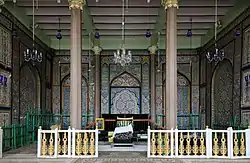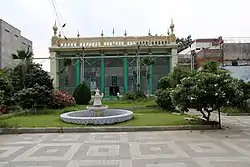| Badshahi Ashurkhana | |
|---|---|
| Native name Ashurkhana | |
 | |
| Location | Hyderabad, India |
| Coordinates | 17°22′09″N 78°28′33″E / 17.369090°N 78.475726°E |
| Built | 1594 |
Badshahi Ashurkhana is an ashurkhana near Charminar in Hyderabad, India. It was constructed in memory of martyrdom of Imam Hussain, and is used during the mourning period of Moharram.[1][2][3]
It is now classified as a heritage site and is looked after by the ancestral hereditary Mutawalli Mujawer Mir Nawazish Ali Moosvi 11 generations custodian along with state Department of Archaeology and Museums.[4]
History

It was built by Muhammed Quli Qutb Shah in 1594, three years after building the Charminar. The brilliantly coloured tile-mosaic decoration was completed under Abdullah Qutb Shah in 1611.[5]
After the Mughal conquest of Hyderabad, in a display of Sunni sectarianism, Aurangzeb used the ashurkhana as a horse stable for the Mughal cavalry, destroying part of the building in the process. The monument was restored by Asaf Jah II in the period 1764-65; a new entry gate was added, along with outer halls and wooden colonnades.[6]
The Monument
Ashurkhana include sites like the Niyaz Khana (offering place), Naqaar Khana (drums place), Sarai Khana's (rest taking place for devotees) Abdar Khana (drinking water place), Langar Khana (food serving place), Makan-e-Mujawer (Mujawer Residence), Daftar-e-Mujawer (Mujawer office), Alawa Chabutra, and Guardroom.[7] The Ashur Khana stands today with enamel tiles that have retained their lustre and vibrant colours even after four centuries. The intricate design in hexagons is exquisite.
References
- ↑ "INTACH awards presented". The Hindu. 20 April 2006. Archived from the original on 13 December 2006. Retrieved 9 February 2012.
- ↑ "Rediscovering the heritage of the city". The Hindu. Archived from the original on 8 November 2011. Retrieved 9 February 2012.
- ↑ Bilgrami, Syed Ali Asgar (1992). Landmarks of the Deccan: A Comprehensive Guide to the Archaeological Remains of the City and Suburbs of Hyderabad. Asian Educational Services. ISBN 9788120605435.
- ↑ "Logo for state archaeology after 90 years". The Times of India. Archived from the original on 22 October 2012. Retrieved 9 February 2012.
- ↑ "Heritage Walk in Hyderabad – Badshahi Ashurkhana".
- ↑ Green, Nile (2004). "Auspicious Foundations: The Patronage of Sufi Institutions in the Late Mughal and Early Asaf Jah Deccan". South Asian Studies. 20 (1): 74. doi:10.1080/02666030.2004.9628637. ISSN 0266-6030. S2CID 194095748.
- ↑ "Remove encroachments at Ashoor Khana: HC". The Times of India. Archived from the original on 2 February 2014. Retrieved 9 February 2012.